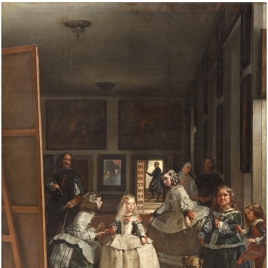Margaret Theresa of Spain
1665 - 1666.Room 016A
Margarita was born on 12 July 1651, the daughter of Philip IV and Mariana of Austria. On 12 December 1666, she married Emperor Leopold of Austria and died seven years later in Vienna. The fact that the princess is wearing mourning dress in this painting helps date it between September 1665 -when her father died- and her wedding in December 1666. Those dates suggest that the portrait was made in order to keep a memento in Madrid that would represent the infanta as she appeared shortly before she left permanently for Vienna. At the same time, it means this canvas is one of Juan Bautista Martínez del Mazo´s last works, for he died in 1667. (The inscription below the chair on the left that erroneously identifies the sitter as her half-sister Maria Teresa is a later, spurious addition.) Margarita is posed frontally, her right arm extended and her hand resting on the back of a chair upholstered in deep crimson fabric, while in her left hand, which hangs at her side, she holds a pair of gloves. Just behind her, to her right, a large curtain drapes from above. This compositional scheme is a familiar one in portraits of queens and infantas painted by Velázquez and members of his circle, and was inaugurated by Velázquez´s portrait Mariana of Austria c.1652 (P1191). The same arrangement would also be deployed by Juan Carreño de Miranda in his Mariana of Austria 1677 (Harrach collection, Austria). The frequent use of this scheme is not only a reflection of tradition, but also is acknowledgment of the fact that, through this particular pose and these attributes, artists had managed to create an image that effectively communicated the connotations of majesty and prudence associated with a queen. Another common element in such portraits is the table clock, which in this case appears in the background, a traditional symbol of the selfcontrol and discretion expected of any woman with royal status. Two things in particular distinguish this painting from the others mentioned above, and these in turn may be found in other portraits of women from the court. On the one hand, there is the presence of the rug, which suggests that the painting was executed during autumn or winter, the time of year when such textiles were used. It is a richly adorned rug, whose details recall those of a rug that appears in another portrait by Mazo of the same princess from some years before (P1192). On the other hand, this image is also distinct in that another room is visible in the background, where several figures dressed in black stand. The most easily identifiable among them is the child with long hair, who holds a sceptre in his right hand and wears the chain of the Order of the Golden Fleece about his shoulders with the badge of the order hanging from it on his chest: elements that indicate he is Charles II, who had just inherited the throne. Beside him is a figure that is not much taller but is noticeably older. It is a dwarf, sometimes identified as Mari Bárbola, who appears in Velázquez´s Las meninas (P1174). The presence of dwarfs alongside princes and kings had become common in imagery of the Spanish court, for they came to be viewed as an attribute of royalty. Behind these two figures is a lady-in-waiting and, standing in the doorway, a woman dressed in widow´s weeds. She has on occasion been identified as Mariana of Austria, who dressed in that manner following Philip IV´s death. This is unlikely, however, because this figure´s pose would have proved improper for a woman of her station. This painting is one of the most important portraits executed in the Spanish court in the decade of the 1660s. It is testimony of the high quality that Mazo had attained in works of this sort, as well as of the persistence of compositional models created by Velázquez (Portús, J.: Portrait of Spain. Masterpieces from the Prado, Queensland Art Gallery-Art Exhibitions Australia, 2012, p. 86).













